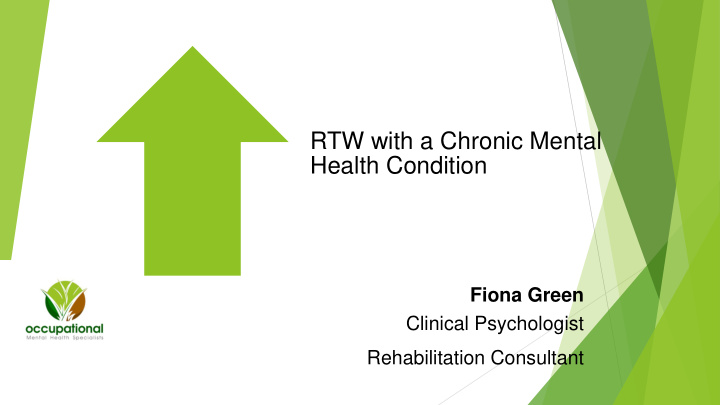



RTW with a Chronic Mental Health Condition Fiona Green Clinical Psychologist Rehabilitation Consultant
Prevalence of Chronic Conditions in Australia Long-term health conditions (ABS Statistics 2015) Mental and behavioural conditions - 4.0 million people (17.5%) Arthritis - 3.5 million people (15.3%) Hypertension - 2.6 million people (11.3%) Asthma - 2.5 million people (10.8%) High cholesterol - 1.6 million people (7.1%) Heart disease - 1.2 million people (5.2%) Diabetes - 1.2 million people (5.1%) Osteoporosis - 801,800 people (3.5%) Cancer - 370,100 people (1.6%) Kidney disease - 203,400 people (0.9%)
Impact of chronic conditions on productivity
Impact of chronic mental health condition on employment
Risk factors of RTW in chronic mental health conditions Older age (50 + years) is associated with continuing disability and longer time to RTW Severity of illness - Nature and severity of specific mental disorders remain strong predictors of disability and RTW Comorbid conditions (physical, substance abuse, or developmental disabilities) History or past sickness absence relates to duration of future disability and time to RTW Negative expectations about recovery predicts a longer time to RTW (Schultz and Rogers 2011, Work Accommodation and Retention in Mental Health)
What are the Goals of Rehabilitation Increasing wellness and functional capacity Returning to employment and productivity
FACTORS- Chronicity in Mental Health Claims Treatment Medical Psychosocial FUNCTION Personal factors – Employability personality, and labour Illness market perception and motivation Workplace Stressors
Vocational Rehabilitation Process Motivation to work • The • Claimant world of Lifestyle modification work Illness Strengths Opportunities Acceptance Barriers Vulnerabilities • Claimant • The world of work
Working with work place triggers • Solve the problem that is causing stress • Build knowledge or skills Reduce exposure time • • Build up my tolerance via exposure • Change my behaviour Create boundaries • • Get organised Can I increase my coping skills • • Can I increase my treatment • Can I make more lifestyle modifications
CASE STUDY Background Self-employed Real Estate Agent, aged 30 years with family of young children Major breadwinner Medical Off work for three months at referral and only just diagnosed with Bipolar II Disorder which later was diagnosed as rapid cycling a more severe presentation Had one hospital stay when saw him and wanted to go back to work immediately Had Psychiatrist but took some time to get a Psychologist as regional area Personal Factors Some what of a goal directed personality, driven, very successful and outcome focused e.g. reported to work twenty hour days when hypomanic Even though referral by insurer was early he was dismissive about rehabilitation and in somewhat of denial about illness. As such he insisted on no rehabilitation first time, went back to work first time and relapsed quite quickly. Was back in hospital for two months Psychosocial Wife supportive of return to work as he was major bread winner
CASE STUDY Workplace Issues / Employability Self employed – pressure to return to work and lack of job security Colleagues- little understanding of his illness and had to adjust to change in his “personality” Very anxious about how much to disclose to agency Customers had to adjust to his “ lack of responsiveness” as no longer working long hours Many of his duties triggered anxiety and depressive symptoms
What we did Development of RETURN TO WORK plan with attention to : A hierarchy of his duties using an anxiety scale identifying symptom triggers Reviewed his bag of tools and strategies for dealing with symptoms at work Built in time for use of relaxation, exercise and stress management at work Encouraged delegation of tasks and boundary setting Regular attendance at Psychiatrist and Psychologist Commitment from treating practitioners via case conferencing and sign off on plan Regular weekly review meetings to encourage him to self monitor his performance, achievements reinforced and changes suggested to improve work functioning Monitored for three months after he returned to work to prevent relapse. Normalised setbacks, encouraged ongoing relapse prevention and resilience
Outcome He returned back to work on full duties, four days but USED a different approach to his work Delegated duties more Planned and controlled the time of day he performed duties Was selective about tasks - cost benefit analysis Paced and used time wisely Had god treatment and symptom identification management strategies Relapse prevention strategies Realised the value of support, exercise, work life balance
Key Messages Chronic Conditions – are enduring, long standing and re occurring. Prevention and Early Intervention are Important. Understanding the Complexity and Impact on Function is important- psycho social, values, personality, employability. Illness Adjustment, Lifestyle Modification and Motivation are dynamic processes throughout the course of a chronic condition. Maintenance and Relapse Prevention are important components in management of the Condition.
Recommend
More recommend